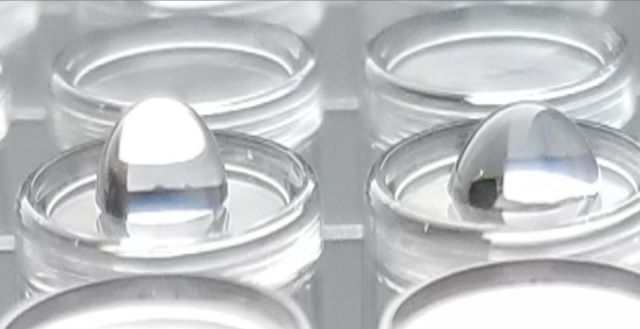Contact : Franz Bruckert, Marianne Weidenhaupt The cell and its environment
The cell senses its environment and modulates its behavior and development according to physico-chemical clues of its surroundings (Figure 1 and 2). In the case of adhesive cells, the underlying material finely tunes spreading kinetics, adhesive strength and orientation. Therefore the material can be used to control cell behavior and, moreover, to investigate the underlying molecular mechanisms active in the cell response.
Our model system is Dictyostelium discoideum, an amoeba that is able to spread and adhere on a large variety of materials. This simple eukaryote is easily amenable to genetic manipulations due to its haploidity albeit sharing many adhesion and motility features with higher eukaryote cells.
Figure 1. Orientational response of D. discoideum to the direction of a flow.
left: Orientation of cells expressing LimE-GFP (actin binding protein) submitted to hydrodynamic shear stress (the flow direction is shown by white arrows).
Right: kinetics of fluorescence distribution at the cell sides opposing and facing the flow (open and closed circles, respectively).
Figure 2. Synchronization of D. discoideum spreading: Cells levitate over a glass surface in 0.17 mM phosphate sucrose buffer. Their spreading is induced by the diffusion of a 170 mM phosphate buffer solution.
We have developed qualitative and quantitative assays to study cell adhesion and spreading on materials using microfluidic systems and different microscopy techniques (fluorescence, reflection interference microscopy (RICM), phase contrast).
We are particularly interested in the following :
- cell spreading and particularly in the establishment of an effective contact between the cell membrane and the material surface, triggering an increase in cell surface contact area
- cell adhesion with a strong interest in adhesive forces developed by the cell
- cell motility and, more precisely, the orientation of the cell during movement
Publications:
- Fache et al. 2005, J. Cell Science 118: 3445-3457.
- Dalous et al., 2007, Biophys. J. 94 : 1063-74.
- Tzvetkova et al., 2009 Microelectronic Engineering, 86, 1485-1487.
- Socol et al., 2010, Bioelectrochemistry 79, 198-210.
Collaborations:
Prof P Cosson, University of Geneva, Dept Cell Physiology and Metabolis



